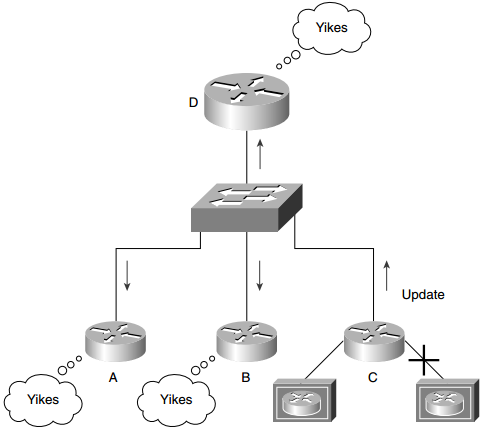CCNP Route FAQ: Using OSPF Across Multiple Areas
Q1. In a totally stubby area, which routes are not propagated into the area?
Q2. Where would you see whether a learned network was within the same area as the router you were looking at?
Q3. An Area Border Router must be resident in which area?
Q4. What does ABR stand for, and what LSAs will it forward?
Q5. State two advantages in creating areas in OSPF.
Answer: The advantages in creating areas in OSPF include these:
- It is easier to manage and administrate.
- It uses a smaller topology table, which reduces the CPU, memory, and network bandwidth consumption.
- Fewer SPF calculations are involved because the topology table is smaller and there is less likelihood of change in the network.
- It uses a smaller routing table if summarization is in operation.

Figure: Maintaining the Topology Table—the Traffic Flow
Q6. What is an external route, and on which type of router will this route be introduced?
Q7. Which command in OSPF shows the network LSA information?
Q8. Why is the use of VLSM important in the design of OSPF?
Q9. Given the networks 144.12.8.0 and 144.12.12.0, both with the mask of 255.255.255.0, is it possible to summarize these into one subnet? If so, state the new subnet and mask.
Q10. What is a discontiguous network?
Q11. A virtual link in OSPF is used to solve what problem?
Q12. State one disadvantage for making an NBMA Frame Relay cloud Area 0.
Q13. State one advantage in making the centralized routers and network resources dwell in Area 0 while the Frame Relay cloud and the stub remote LANs reside in satellite stub areas.
Q14. How does creating the number of areas in OSPF reduce the number of SPF calculations?
Q15. How does a stub area differ from the backbone area?
Q16. How does a totally stubby area differ from a stub area?
Q17. State the different LSA types.
Answer: The different LSA update types are as follows:
- Router link—Sent by the router, stating the links directly connected. These are flooded through the area. This update is identified by the type code Type 1.
- Network link—Sent by the designated router, stating the links for the LAN for which it is the designated router. These LSAs are flooded throughout the area. This update is identified by the type code Type 2.
- Summary link—Sent by the ABR into the backbone. It states the IP subnets within the area that are to be advertised into other areas. This is where summarization would be configured. This update is identified by the type code Type 3.
- Summary link (to an ASBR)—Sent from an ABR to a router that connects to the outside world (ASBR). It contains the metric cost from the ABR to the ASBR. This update is identified by the type code Type 4.
- External link—Sent to the ASBRs to which the organization is directly connected. This update is identified by the type code Type 5.
Q18. Where does the backbone router reside, and what is its function?
The backbone must be at the center of all other areas—that is, all areas must be physically connected to the backbone. The reasoning behind this is that OSPF expects all areas to inject routing information into the backbone; in turn, the backbone will disseminate that information into other areas.
Q19. Are there any considerations for OSPF configured with VLSM sending routing updates into RIPv1?
Q20. There are two types of summarization. What are they?
Answer: The two types of summarization are these:
- Interarea route summarization—These routes are sent between areas. The ABR will summarize routes if the network within the area was designed using contiguous addresses, conforming to both a physical and a logical hierarchy.
- External route summarization—These are routes sent into OSPF from another routing protocol. This summarization also demands a hierarchical design using contiguous addresses. This is employed at the ASBR.
Q21. Can the following subnets with a mask of 255.255.255.0 be summarized? If so, state the subnet and mask that can be used.
Q22. Why can interarea summarization be configured only on ABRs?
19.44.16.0
19.44.17.0
19.44.18.0
19.44.19.0
19.44.20.0
19.44.21.0
19.44.22.0
19.44.23.0
19.44.24.0
19.44.25.0
19.44.26.0
19.44.27.0
19.44.28.0
19.44.29.0
19.44.30.0
19.44.31.0
Q23. What command would be used to create a totally stubby area?
Q24. What is a virtual link, and what command would be used to create it?
Q25. Where would you issue the command to summarize IP subnets? State the command that would be used.
Q26. How would you summarize external routes before injecting them into the OSPF domain?